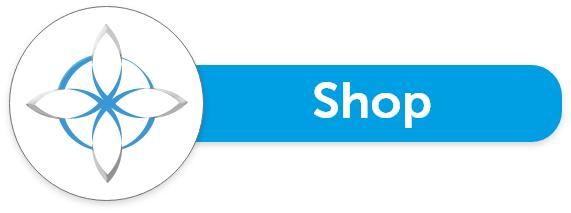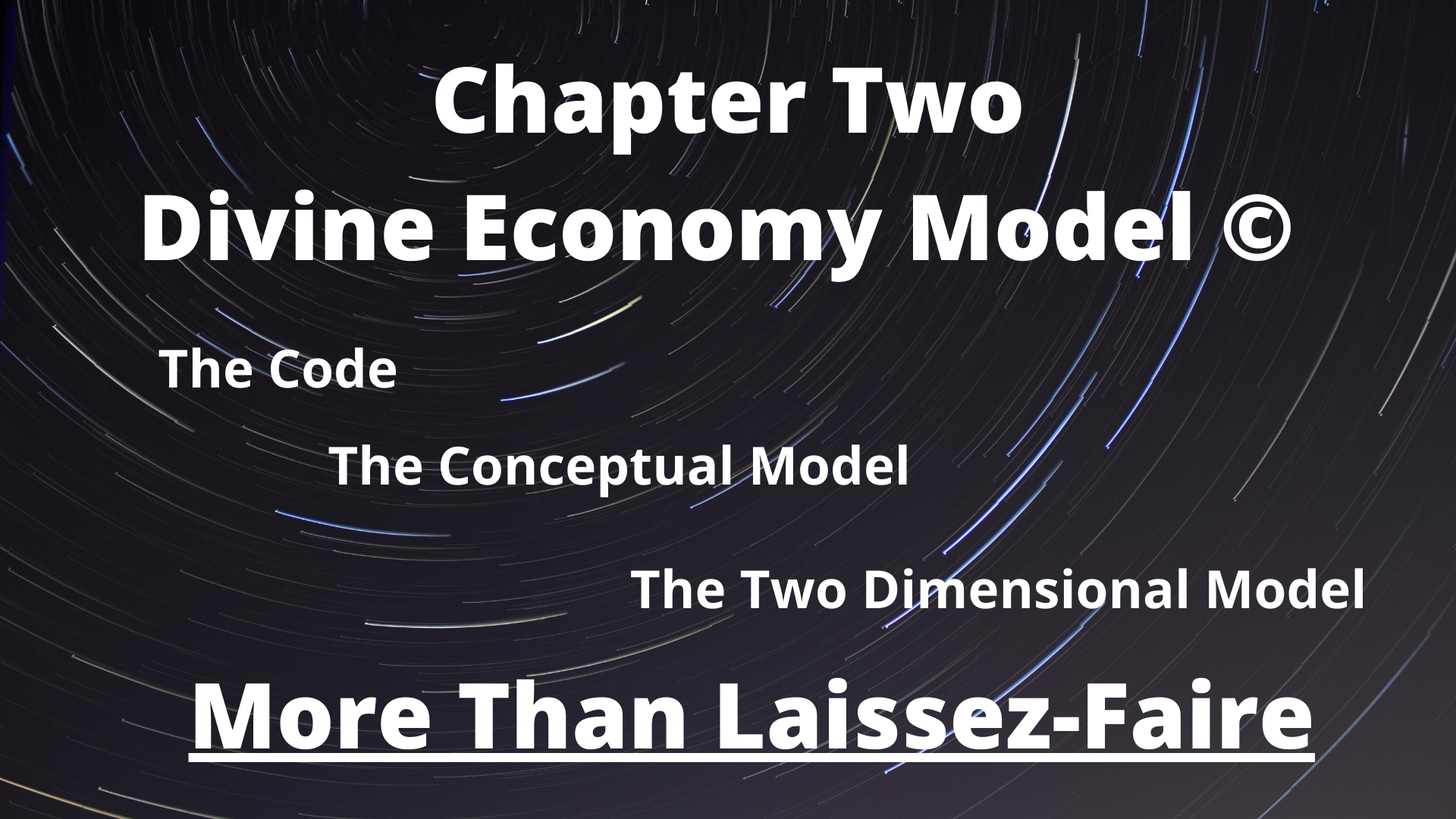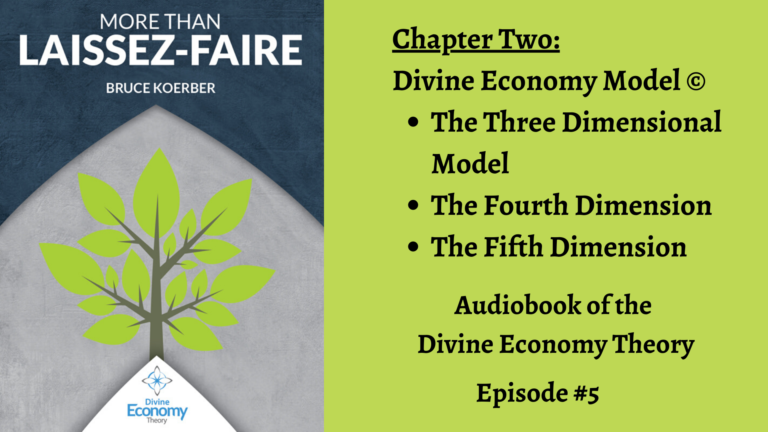The Divine Economy Model © is organic and subjective and splendid! This is a human action model for you to see, but it is first necessary for you to be on a quest for knowledge. It is that specific action by you that will put you in the right place.
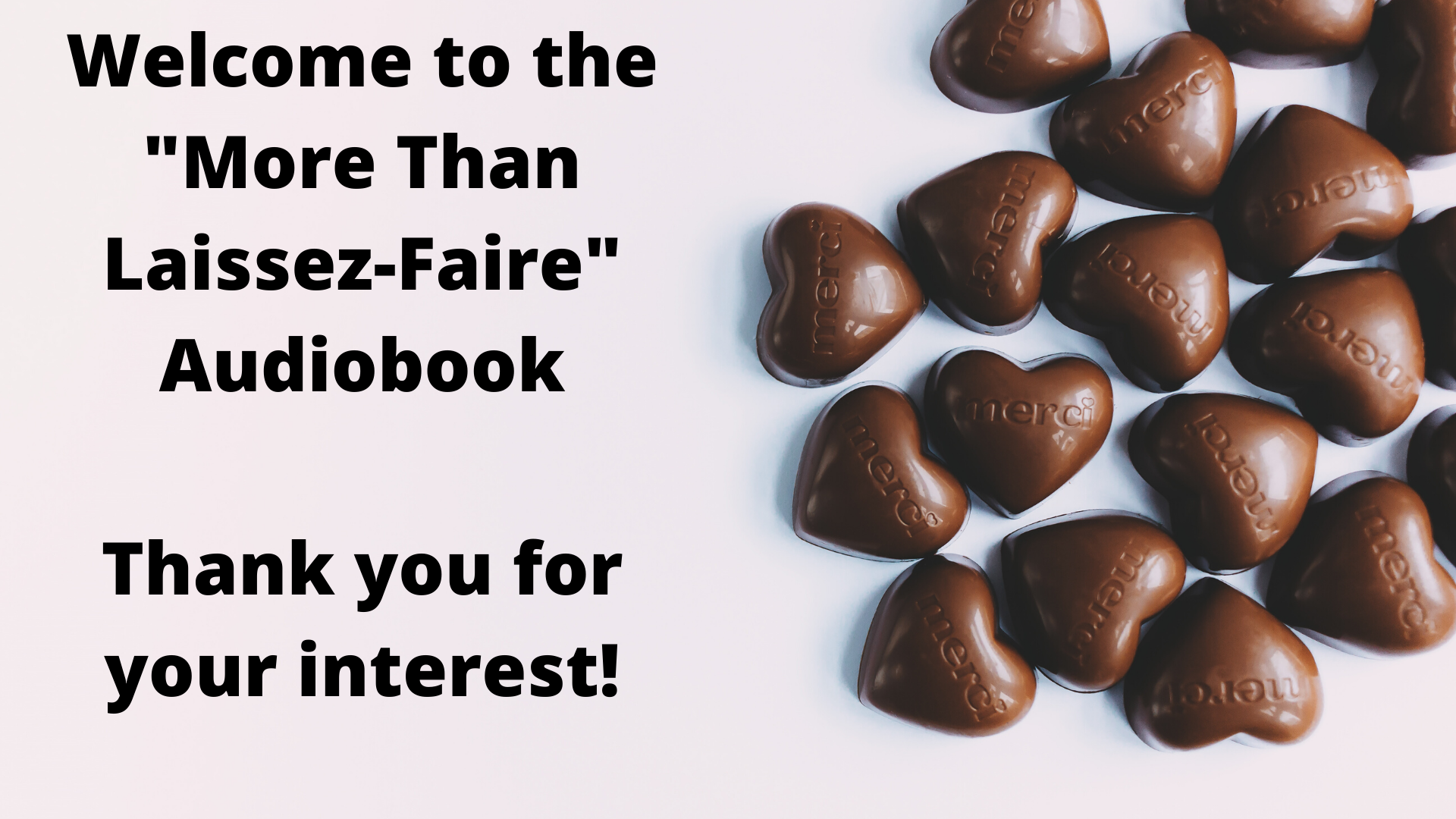
Here’s the video recording of this session of the audiobook. Below is the transcript.
You can contact me if you have any questions.
Preface
Our journey has now brought us face-to-face with another ‘life force.’ Unlike the fire encountered in the forest, this ‘life force’ is organic and subjective. Yet it is similar to the fire since it, too, is splendid. It is organic because of its symmetry and reciprocity and because it manifests characteristics of life. Its life-likeness is directly attributable to its DNA and its RNA; that is, to its foundation and its operation, which rest upon subjectivism. From this subjective nature we see what can fittingly be described as dynamic splendor.
The Code
Shortly I will begin to present to you a graphical representation of the divine economy model. But before we begin examining the model we will want to understand the conceptual basis of what is called the Cartesian coordinate system. In mathematics the applications of the two dimensional coordinate system and of the three dimensional coordinate system appear to be very empirical. Despite being used mostly for empirical work the Cartesian coordinate system is not restricted from more conceptual applications, as proven when it is expanded to higher dimensions, for example, the fourth dimension, the fifth dimension or even to the 𝑛th ‘degrees of freedom.’
I take advantage of the conceptual potentialities of the Cartesian coordinate system and use it as a part of the design of my subjective model. Just as the higher dimensions are abstract I make all of the dimensions of my model abstract. Referring to the Cartesian coordinate system, Bernhard Riemann in 1854 described the value of this abstraction: “Abstract studies such as these allow one to observe relationships without being limited by narrow terms, and prevent traditional prejudices from inhibiting ones progress.” In my model the two dimensional system is subjective or ‘abstract’ as is the third dimension and the fourth dimension and the fifth dimension, in other words, my model is five dimensional.
The Conceptual Model
Now I will introduce the divine economy model to you, it is a human action model. As the model is presented; its interconnectedness, reciprocity and symmetry will be discussed. One analogy that may prove useful is that of a complex organism made up of components that are more or less differentiated. Ourselves, we are made up of systems and organs and tissues and cells. Likewise the divine economy model has universal laws, foundational elements, concepts, and principles.
The center of the model is its reality and essence, summed up using the words ‘divine economy.’ These two powerful words clearly state the vital perspective of this model. These two words efficiently convey the source and the dominion. The implication here is far more magnificent than laissez-faire which merely suggests ‘not to meddle.’ The implication here is that the economy is above and beyond our human understanding and that it can be and is corrupted by human intervention alone.
The divine economy is both pervasive and subtle and its dominion reaches everyone in their daily affairs. It is basic and connected to the necessary acts of every man and woman and by its conveyance of information it allows people to function.
The Two Dimensional Model
Just as there are four cardinal directions; a north and south and east and west, the organic divine economy model has four petals. Gleaned from the knowledge and insight of many great thinkers I chose the following petals for the model: human spirit, transformation, law, and order. What we have is the model in its simplest form (see Diagram 2a).
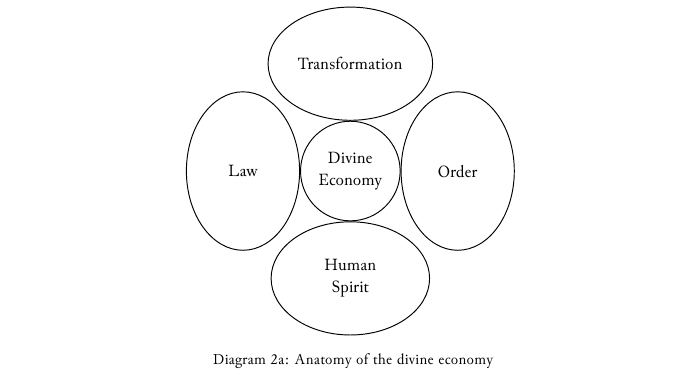
To the model we then add reciprocity and symmetry (Diagram 2b). From now on you will notice arrows on both ends of the lines to represent reciprocity and symmetry. The element of reciprocity adds the dimension of mutual exchange. Another way to describe what happens during an exchange is to see exchange as the fulfillment of the double inequality of wants. I want what you have more than what I have and you reciprocate those feelings, therefore we exchange.
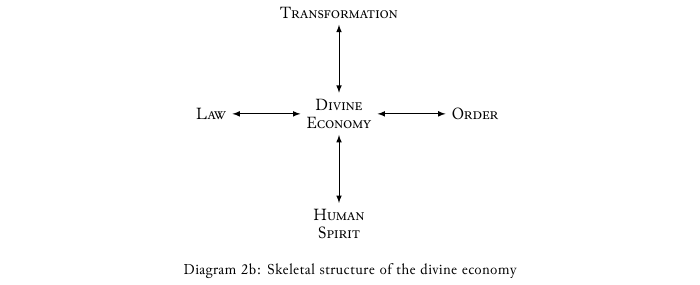
Proportionality and relativity manifest themselves in the world via the element of symmetry. For example, as transformation within the economy increases the other vital elements of the economy also increase and the economy as a whole increases. The model now becomes what is seen in Diagram 2b. In this form the functionality of the model begins to emerge. It has a dynamic nature. Every point is relative to every other point and every understanding gained causes movement, advancing civilization.
To continue to improve the functionality of the model more scientific elements of the economy are added. These economic elements were discovered by great thinkers in the tradition of classical liberalism. These certain points of focus are added to the skeletal structure as intermediary potencies.
To the skeleton we add more substance making the model more realistic and bringing it to life. To the human spirit appendage we add action, purposeful action. To the transformation appendage we add capital structure. The law appendage fills out nicely with property rights and it is the market that beefs up the order appendage.
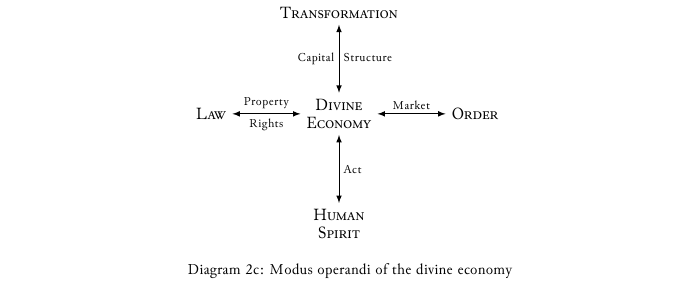
With this added substance, as shown in Diagram 2c, it begins to become evident to us how the model neatly incorporates the intermediary elements that make it operational. Using the analogies of a skeletal structure and appendages reminds us about the organic nature of the model.
This is the highest form of the two dimensional model and this is where the model begins to become complex. We will have to take a step back and examine more deeply the foundational components. Then the extremely potent intermediary elements will need to be explored.
Going back to the skeletal structure of the divine economy in Diagram 2b it is easy to see how interactive and cumulatively interactive it is. The human being has a nature that is subject to illumination. It is the human spirit that reflects that reality. Transformation is the illumination that takes place and this all comes about because we encounter the human spirit of others, directly or indirectly. The world is not a vacuum, people learn from others and from their environment.

The world has structure and incorporating structure into our lives creates order. Transformation is furthered by discovering the operational laws of that order. Completing the circle, then, the human spirit is illumined by the transformation that has taken place.
The dynamic interaction of all of these interrelated elements is certain. Already it is clear that the complexity of the divine economy is mind boggling. We have to trust in its divine nature and content ourselves with understanding bits and pieces, ever humbled by the infinite greatness of the divine economy.
Now moving on to the more complex model in Diagram 2c— the modus operandi of the divine economy—we need to spend some time educating and re-educating ourselves about these intermediary elements. It would be inaccurate and naïve to pretend that there is a common understanding of these four elements in the economic literature or in the minds of most readers.

The four scientific elements that make up the modus operandi of the divine economy are property rights, human action, the market, and capital structure. These are potent forces which universally permeate human life on this planet!
Placement of these intermediate elements into the model relative to the initial foundational components expands the foundation of the model. The model readily accommodates the fluid manner in which these eight elements all juxtapose themselves.
Property rights interface closely with human action, the market and the capital structure. Property rights are truly foundational and have a strong connection to law in the divine economy since they anchor the economy to the human being. In its most basic and primary expression, property rights are human rights. The existence of a human being grants dominion, and its peaceful expansion toward food, clothing and higher attainments all fall within the domain of property rights.
The human spirit—each one of us as a unique expression of the grace of God—becomes foundational in the divine economy through human action. Human action is the expression of the human spirit, which implies that the human spirit is the locus of communication and serves as a channel for the two-way flow of knowledge.
Understanding that the economy is a uniquely human institution means there is also cognition that the human spirit is where it all begins and human action is where it becomes manifest.Without human beings, whose nature it is to act purposefully, there would be no economy.
There is a saying: ‘It takes two to tango!’ That is what the market is. It is the place where the solitary individual becomes a social being.
By this very broad definition the interaction of parents with their children could even be considered a market. Although an argument could be forwarded against this line of reasoning such an argument does not allow this very important point to be made therefore it serves no purpose here. The purpose of this broad definition is to remove the limiting definitions ascribed to the market and to remove the prejudices about the market.
The market is where individual human action undergoes reconfiguration into a more social entity. This is part of the dynamics between the ‘act’ and the ‘transformation.’ The market is where knowledge flows to and from in a civilization. And it is from this proverbial fountain of knowledge that order emerges. See Diagram 2d.

The three scientific elements just described—property rights, human action, and the market—are inherent and found in full potential in the divine economy.
The fourth element differs slightly from the others because of its very strong ties to time. The fourth element, capital structure, is also foundational. It contains and conveys the knowledge that all things in this world are subject to the law of time. Capital, the means of stretching production beyond the present, is necessarily foundational also.
Most significantly, of all factors in the economy capital is the most limiting. See if you understand why. Ponder: in the here and now—in the present—we cannot live in the future! That is our limitation. The reason capital is the most limiting is because it is what connects the present and the future in the economy within ‘our limitation.’ It is constrained by uncertainty yet its variation or structure determines the transformation that takes place in the economy.
Since capital is the most limiting factor, the movement or advancement of civilization depends heavily upon the structure of capital. This necessitates, optimally, that the capital structure needs to be a harmonious expression of the market so that it truthfully reflects the will of the people. In the divine economy fully vested human beings find and share knowledge in the market. Part of that knowledge reflects the importance of time which becomes manifest in capital and its relevant structure.
Here’s the video recording of this session of the audiobook.
If you want to be notified at the time when the audiobook is Live on Facebook sign up here.


